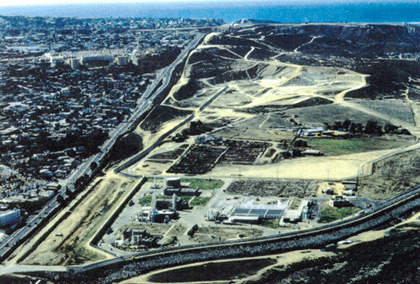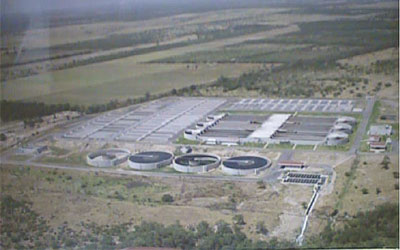Home >
Wastewater Treatment Plants
South Bay International Wastewater Treatment Plant, San Ysidro, California
The SBIWTP is a 25 million gallon per day secondary treatment plant located in San Diego County, California, about 2 miles west of the San Ysidro Port of Entry. The plant treats sewage originating in Tijuana, Mexico and discharges it to the Pacific Ocean through the South Bay Ocean Outfall, a four and one-half mile long 11foot diameter pipe completed in January 1999. From here you can link to various informative pages about the SBIWTP located in San Ysidro, CA.
 The South Bay International Wastewater Treatment Plant (SBIWTP) was designed to deal with the growing demand for the treatment of wastewater resulting in the contamination of the Tijuana River in the United States. It has been an ongoing concern since 1934 when the International Boundary Commission (IBC) was instructed by the United States and Mexican governments to cooperate in the preparation of a report on the Tijuana sewage problem. The SBIWTP is capable of providing secondary treatment for 25 million gallons per day (mgd) average daily flows of sewage in excess of the Tijuana sewage system capacity, but has expansion capability of up to 100 mgd. The SBIWTP was built on a 75-acre site near the international boundary in the U.S. immediately north of Tijuana's main wastewater pumping station. Resulting from the establishment of a binational interagency "Clean Water Partnership," the United States and Mexico approved IBWC Minute No. 283 dated July 8, 1990. This Minute authorized the construction of the SBIWTP. The Government of Mexico contributed $16.8 million toward construction of the SBIWTP and currently contributes $2.0 million toward the annual operation and maintenance costs. Funding for the U.S. share of construction costs was appropriated through the Environmental Protection Agency in the amount of $239.4 million. Of that amount, $225.5 million had been obligated as of 2002, of which $89.2 million was given to the City of San Diego and the Corps of Engineers to construct the South Bay Ocean Outfall; $8 million was given to the Corps of Engineers for environmental work; and $127.4 million was given to the USIBWC for the costs associated with the construction of the SBIWTP and related infrastructure. Mexico's share is that amount that Mexico would have had to pay to construct and maintain a plant at the Rio Alamar. At the same time, Mexico is expanding its sewage collection system, and constructing additional works necessary to collect and convey Tijuana's sewage. These facilities will be operated and maintained at Mexico's expense. Both countries share in the operation and maintenance of the SBIWTP.
The South Bay International Wastewater Treatment Plant (SBIWTP) was designed to deal with the growing demand for the treatment of wastewater resulting in the contamination of the Tijuana River in the United States. It has been an ongoing concern since 1934 when the International Boundary Commission (IBC) was instructed by the United States and Mexican governments to cooperate in the preparation of a report on the Tijuana sewage problem. The SBIWTP is capable of providing secondary treatment for 25 million gallons per day (mgd) average daily flows of sewage in excess of the Tijuana sewage system capacity, but has expansion capability of up to 100 mgd. The SBIWTP was built on a 75-acre site near the international boundary in the U.S. immediately north of Tijuana's main wastewater pumping station. Resulting from the establishment of a binational interagency "Clean Water Partnership," the United States and Mexico approved IBWC Minute No. 283 dated July 8, 1990. This Minute authorized the construction of the SBIWTP. The Government of Mexico contributed $16.8 million toward construction of the SBIWTP and currently contributes $2.0 million toward the annual operation and maintenance costs. Funding for the U.S. share of construction costs was appropriated through the Environmental Protection Agency in the amount of $239.4 million. Of that amount, $225.5 million had been obligated as of 2002, of which $89.2 million was given to the City of San Diego and the Corps of Engineers to construct the South Bay Ocean Outfall; $8 million was given to the Corps of Engineers for environmental work; and $127.4 million was given to the USIBWC for the costs associated with the construction of the SBIWTP and related infrastructure. Mexico's share is that amount that Mexico would have had to pay to construct and maintain a plant at the Rio Alamar. At the same time, Mexico is expanding its sewage collection system, and constructing additional works necessary to collect and convey Tijuana's sewage. These facilities will be operated and maintained at Mexico's expense. Both countries share in the operation and maintenance of the SBIWTP.
Nogales International Wastewater Treatment Plant, Nogales, Arizona
The Nogales International Wastewater Treatment Plant, (NIWTP) is adjacent and westerly of the Santa Cruz River/Nogales Wash confluence, about ten miles north of Ambos, Nogales. It treats a daily average dry weather flow of approximately fifteen million gallons, of which approximately eighty per cent is from Mexico.
 A technology upgrade of the NIWTP was completed in August of 2009. This upgrade consisted of adding equipment and apparatus to upgrade the technology of the NIWTP to a Biological Nutrient Removal (BNR) system using the Modified Ludzack-Ettinger process. This process allows for the removal of Nitrogen compounds in the discharged effluent which had been shown to be detrimental to the fish & wildlife along the Santa Cruz River. The technology upgrade cost approximately $64 million dollars and was funded largely by a grant from the Environmental Protection Agency (EPA) thru the Border Environment Infrastructure Fund (BEIF).
A technology upgrade of the NIWTP was completed in August of 2009. This upgrade consisted of adding equipment and apparatus to upgrade the technology of the NIWTP to a Biological Nutrient Removal (BNR) system using the Modified Ludzack-Ettinger process. This process allows for the removal of Nitrogen compounds in the discharged effluent which had been shown to be detrimental to the fish & wildlife along the Santa Cruz River. The technology upgrade cost approximately $64 million dollars and was funded largely by a grant from the Environmental Protection Agency (EPA) thru the Border Environment Infrastructure Fund (BEIF).
The project is staffed by seventeen persons, including administrative support and is Operated and Maintained by the United States Section of the International Boundary & Water Commission. Total yearly operation and maintenance cost is about $4.5 million dollars. Mexico, the City of Nogales, Arizona, and the U. S. Congress fund the project based upon flow contributions to facility from each country. In addition to responding to federal and state permits, the NIWTP provides river-based habitat for approximately ten downstream miles as well as replenishment of the aquifers serving Santa Cruz and Pima County communities.
Nogales Stormwater Infrastructure Presentations / Reports
Reports Concerning the NIWTP
Nuevo Laredo Wastewater Treatment Plant
 The Nuevo Laredo International Wastewater Treatment Plant is an activated sludge—extended aeration—wastewater treatment plant located adjacent to the Rio Grande, 7 miles downstream of Nuevo Laredo, Tamaulipas, Mexico. The plant has a maximum design capacity of 31 million gallons per day (mgd) and is currently treating 20 to 22 mgd of domestic sewage from the City of Nuevo Laredo to the secondary level that would otherwise flow untreated directly into the Rio Grande. The project was undertaken pursuant to IBWC Minute No. 279 to improve the quality of the waters of the Rio Grande in the area of Laredo, Texas/Nuevo Laredo, Tamaulipas and was jointly financed by the United States and Mexican Governments.
The Nuevo Laredo International Wastewater Treatment Plant is an activated sludge—extended aeration—wastewater treatment plant located adjacent to the Rio Grande, 7 miles downstream of Nuevo Laredo, Tamaulipas, Mexico. The plant has a maximum design capacity of 31 million gallons per day (mgd) and is currently treating 20 to 22 mgd of domestic sewage from the City of Nuevo Laredo to the secondary level that would otherwise flow untreated directly into the Rio Grande. The project was undertaken pursuant to IBWC Minute No. 279 to improve the quality of the waters of the Rio Grande in the area of Laredo, Texas/Nuevo Laredo, Tamaulipas and was jointly financed by the United States and Mexican Governments.
The construction and operation and maintenance of this joint international sanitation project were undertaken under the supervision of the Commission and under the jurisdiction of the Mexican Section. Minute 279 also provided for the construction of sewage collector lines in Nuevo Laredo and construction of a lift station, with pumping capacity of 82 mgd.
Prior to construction of the plant, 70% of the population of Nuevo Laredo was connected to the Nuevo Laredo sewage collection system, which discharged an average of 20 to 25 mgd of untreated sewage to the Rio Grande from more than 28 location, creating a serious health hazard in the river for a distance of 41 miles downstream. Downstream of the Laredo, Texas/Nuevo Laredo, Tamaulipas urban area, large areas of lands in both the United States and Mexico were irrigated with water pumped directly from the river. Using contaminated water for crops presented a potentially serious health threat to the people consuming agricultural products irrigated with those waters. Also, the contaminated waters of the Rio Grande posed a serious health hazard to the communities of San Ignacio, Texas and San Ignacio, Tamaulipas, located 40 miles downstream of Laredo, Texas/Nuevo Laredo, Tamaulipas, which obtained their drinking water from the river. During periods when the Falcon International Storage Reservoir was not generating high river flows, the pollution generated in the Laredo, Texas/Nuevo Laredo Tamaulipas area also posed a threat to the municipal water systems at Zapata, Texas and Nuevo Ciudad Guerrero Tamaulipas.
Construction took place from March 1992 to December 1994, but was suspended for a year due to the devaluation of the peso. Construction resumed in August 1995 and was substantially completed in April 1996. The plant was dedicated and began operations on April 17, 1996, pending completion of the waste sludge drying beds. This final phase of construction was begun in 1998 and completed in January 2000. The final cost of the treatment plant and associated pump station was close to $60 million.

